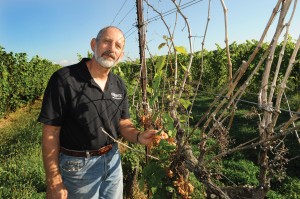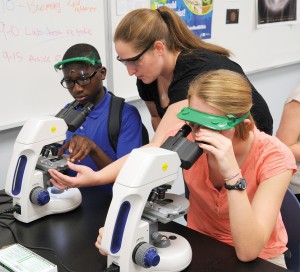
Nick Ferrante checks his vineyards in Ashtabula County. The winter of 2013-14 devastated his crop. But OARDC research offers hope for recovery.
The “polar vortex” winter of 2013–2014 hit Ohio’s wine grapes hard. Nick Ferrante knows it. The owner of Geneva’s Ferrante Winery lost his entire 2014 vinifera crop. And he wasn’t alone. Ohio grape growers estimated their vinifera losses at 97 percent, and officials expected damage to all the state’s grape varieties to top $12 million. Vinifera, or European, grapes go into such wines as Chardonnay.
“This was probably the worst grape damage on record in Ohio,” said Imed Dami, who works to help growers recover from that damage and reduce or prevent it in the future.
As leader of the Ohio Agricultural Research and Development Center’s viticulture, or grape-growing, research, Dami studies, for example, new grape varieties’ cold hardiness and how to prune winter-damaged vines. Then he shares his findings for growers to use — a sustained flow of new science-based knowledge that Ferrante calls “a great asset to the industry.”
Essentials
- OARDC’s grape and wine research program is the only long-term, university-backed research program serving Ohio’s grape and wine industry.
- Ohio’s grape and wine industry has a $786 million annual economic impact, a figure that has grown by a third in just the past six years.
- The industry created 1,200 new jobs during that growth and now supports more than 5,000 full-time jobs.
- Following last winter’s devastation, Dami has taught an ongoing statewide workshop series on pruning winter-damaged vines. The goal is to return Ohio grape growers to full production as soon as possible.
- Dami and colleagues do extensive research on improved grape production methods. Field trials take place in Wooster, at OARDC’s Ashtabula Agricultural Research Station in Kingsville and in vineyards of cooperating growers.
- Dami has attracted nearly $3.4 million in grant support from industry and others since 2008.
“Imed Dami’s research has impacted all of Ohio’s vineyards, especially in the Grand River Valley, which produces some of the state’s finest vinifera wines and has won many prestigious awards,” Ferrante said. “We’ve used many of Imed’s strategies to improve vine health, yields and wine quality.”
More: go.osu.edu/GrowingGrapes






